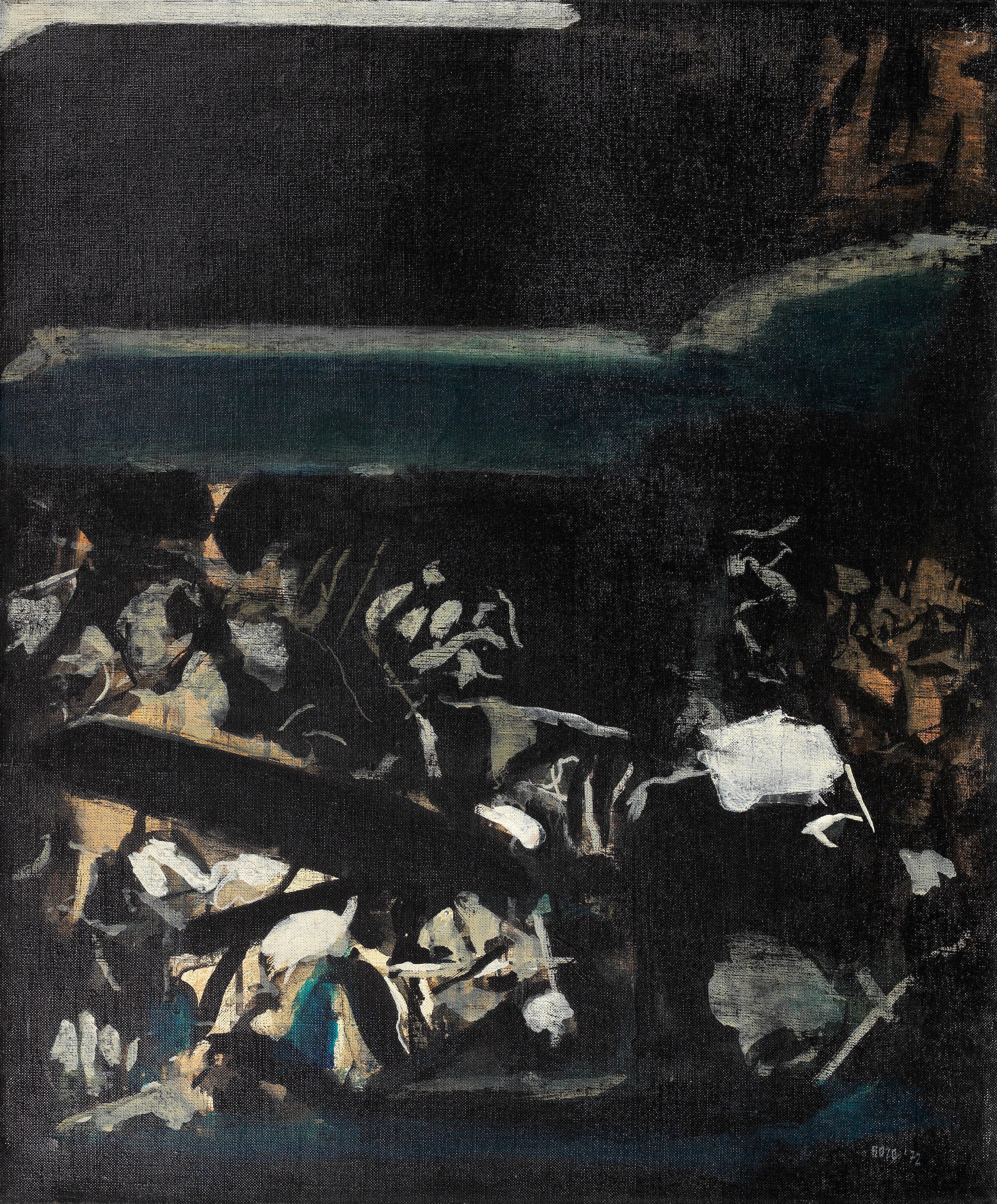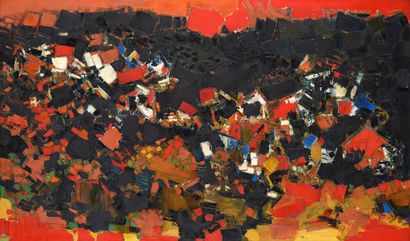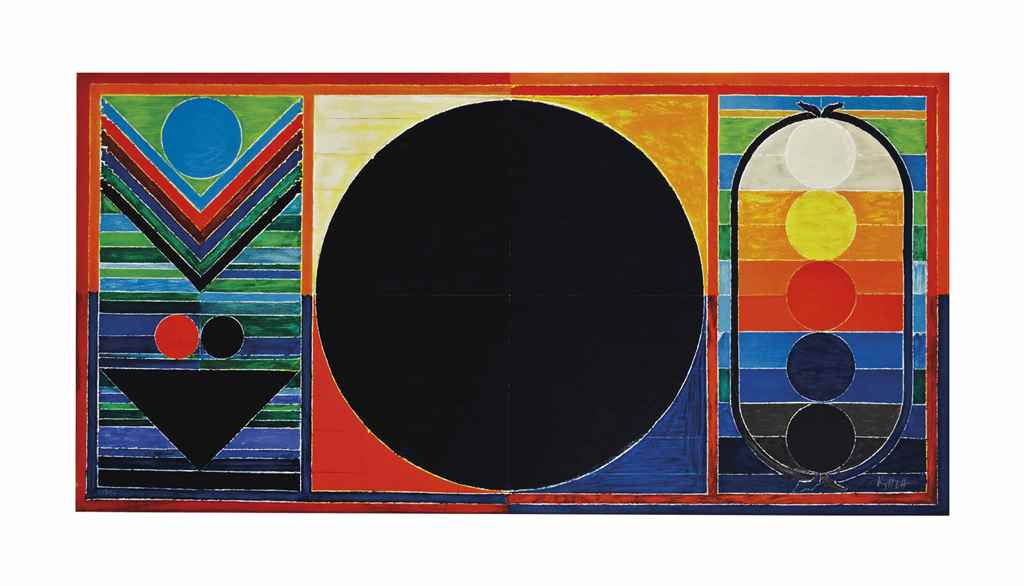Sayed Haider Raza (Indian, 1922-2016)Les Rochers signed and dated 'Raza 69' lower centre, further signed, dated, titled and inscribed Raza/P_782 '69/Les Rochers/10F and 'SHR-26' verso and 'YK520 CIN' on the stretcher oil on canvas 54.7 x 46cm (21 9/16 x 18 1/8in).FootnotesCELEBRATING SAYED HAIDER RAZA'S BIRTH CENTENARY AND 75 YEARS OF THE PROGRESSIVE ARTISTS Provenance Acquired by the owner from Galerie Lara Vincy, Paris (acquired directly from the artist; Private Collection, France (acquired from the above) Christies, South Asian Modern & Contemporary Art,11th June 2012, lot 55. Acquired by the current owner from the above. Literature Anne Macklin (ed.), SH Raza, Catlogue Raisonné 1958-1971 (Volume I), Vadehra Art Gallery & he Raza Foundation, New Delhi, 2016, p. 173 (illustrated) A fascinating aspect of Raza's long career lies in how he evolved at least three different modes of abstraction – and their particular reflection on his own life and experiences. At the time of painting these small works, Raza was going through one of the most significant periods of his painterly career. His stint at the JJ school, the early years in Paris and his exposure the life of an artist in post war Europe was already behind him. This phase may well have started during the early 1960s, when he travelled to the University of California at Berkeley from France and experienced for the first time the works of Sam Francis Mark Rothko and other leading American abstract expressionists, who lent their work the primacy of colour. Completely devoid of any structure, allowing for a fluid evocation of emotion, their work led Raza to move dramatically beyond the School of Paris influences that he had hitherto been exposed to. As he allowed himself greater painterly freedom in the unfolding decade of the sixties, Raza's work was to become more gestural, the brushwork looser, and the painterly affect that he sought more emotive. Yet nothing about this confluence of impressions was simple or direct. An artist of his time who responded spontaneously to the great wave of abstraction that swept the West in the 1950s and 60s, Raza also had nurtured a slew of memories that tied him inextricably with his homeland. As he describes it, the dense forests surrounding Mandla, a district in Madhya Pradesh where his father served as a forest officer were an overwhelming memory, of a sensorium of sounds, shadow and movement, unknown and mysterious to the young child. The weight of the night as it descended on the forest – innocent of electricity, as the villagers returned to their homes - was occasionally broken by the dances and singing of the Gond tribals by firelight, which etched deeply on his impressionable mind. Years later, as he engaged with a more liberated, and spontaneous mode of painting, Raza reverted to that childhood memory, making his works rich with an inchoate movement, and the irrepressible pulsation of life. There was also the memory of Kashmir, which Raza visited in 1947, its rich explosion of colours and its landscape, the subject of a wealth of miniature paintings. Les Rochers (1969) The two small paintings on view cohere in terms of Raza's treatment; whether these are preparatory works for larger canvases or complete in themselves, they bear the dynamism and energy of this phase. In the earlier work titled Les Rochers (1969) Raza allows a heavy overhang of darkness to seemingly merge with the large rock like forms, making one indistinguishable from the other. The sense of a looming darkness, kindled by embers of colour that seem to rise at the base of the work suggests the deepening of shadow over the landscape, like the closing in of the night. About this time Raza was to make a series of works drawing upon the rich tones of Rajasthani paintings – red, black, white and yellow—which not only drew from the burning sands of the Malwa region and the blazing sun of the desert but the passionate music of Rajputana, and the rich symbolism of Tantric pa
Sayed Haider Raza (Indian, 1922-2016)Les Rochers signed and dated 'Raza 69' lower centre, further signed, dated, titled and inscribed Raza/P_782 '69/Les Rochers/10F and 'SHR-26' verso and 'YK520 CIN' on the stretcher oil on canvas 54.7 x 46cm (21 9/16 x 18 1/8in).FootnotesCELEBRATING SAYED HAIDER RAZA'S BIRTH CENTENARY AND 75 YEARS OF THE PROGRESSIVE ARTISTS Provenance Acquired by the owner from Galerie Lara Vincy, Paris (acquired directly from the artist; Private Collection, France (acquired from the above) Christies, South Asian Modern & Contemporary Art,11th June 2012, lot 55. Acquired by the current owner from the above. Literature Anne Macklin (ed.), SH Raza, Catlogue Raisonné 1958-1971 (Volume I), Vadehra Art Gallery & he Raza Foundation, New Delhi, 2016, p. 173 (illustrated) A fascinating aspect of Raza's long career lies in how he evolved at least three different modes of abstraction – and their particular reflection on his own life and experiences. At the time of painting these small works, Raza was going through one of the most significant periods of his painterly career. His stint at the JJ school, the early years in Paris and his exposure the life of an artist in post war Europe was already behind him. This phase may well have started during the early 1960s, when he travelled to the University of California at Berkeley from France and experienced for the first time the works of Sam Francis Mark Rothko and other leading American abstract expressionists, who lent their work the primacy of colour. Completely devoid of any structure, allowing for a fluid evocation of emotion, their work led Raza to move dramatically beyond the School of Paris influences that he had hitherto been exposed to. As he allowed himself greater painterly freedom in the unfolding decade of the sixties, Raza's work was to become more gestural, the brushwork looser, and the painterly affect that he sought more emotive. Yet nothing about this confluence of impressions was simple or direct. An artist of his time who responded spontaneously to the great wave of abstraction that swept the West in the 1950s and 60s, Raza also had nurtured a slew of memories that tied him inextricably with his homeland. As he describes it, the dense forests surrounding Mandla, a district in Madhya Pradesh where his father served as a forest officer were an overwhelming memory, of a sensorium of sounds, shadow and movement, unknown and mysterious to the young child. The weight of the night as it descended on the forest – innocent of electricity, as the villagers returned to their homes - was occasionally broken by the dances and singing of the Gond tribals by firelight, which etched deeply on his impressionable mind. Years later, as he engaged with a more liberated, and spontaneous mode of painting, Raza reverted to that childhood memory, making his works rich with an inchoate movement, and the irrepressible pulsation of life. There was also the memory of Kashmir, which Raza visited in 1947, its rich explosion of colours and its landscape, the subject of a wealth of miniature paintings. Les Rochers (1969) The two small paintings on view cohere in terms of Raza's treatment; whether these are preparatory works for larger canvases or complete in themselves, they bear the dynamism and energy of this phase. In the earlier work titled Les Rochers (1969) Raza allows a heavy overhang of darkness to seemingly merge with the large rock like forms, making one indistinguishable from the other. The sense of a looming darkness, kindled by embers of colour that seem to rise at the base of the work suggests the deepening of shadow over the landscape, like the closing in of the night. About this time Raza was to make a series of works drawing upon the rich tones of Rajasthani paintings – red, black, white and yellow—which not only drew from the burning sands of the Malwa region and the blazing sun of the desert but the passionate music of Rajputana, and the rich symbolism of Tantric pa


.jpg)
.jpg)
.jpg)






.jpg)



Testen Sie LotSearch und seine Premium-Features 7 Tage - ohne Kosten!
Lassen Sie sich automatisch über neue Objekte in kommenden Auktionen benachrichtigen.
Suchauftrag anlegen